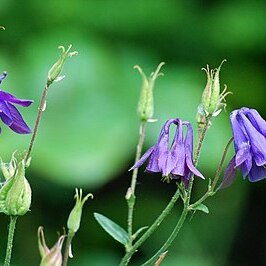Herbs perennial. Stems numerous, erect. Basal leaves 1--3 × ternately compound, long petiolate; leaflets lobed or parted. Stem leaves similar to basal ones but smaller. Inflorescences cymose, umbelliform, or sometimes 1-flowered; bracts leaflike, not involucral. Flowers radially symmetric, bisexual. Sepals 5, spreading. Petals 5, erect to suberect, usually smaller than sepals, base usually prolonged into a spur. Stamens numerous; filaments linear-filiform, 1-veined. Staminodes ca. 7, membranous. Pistils (4)or 5(--10); style ca. 1/2 as long as ovary; ovules numerous. Follicles narrowly cylindric, prominently veined; styles persistent. Seeds numerous, black, narrowly obovoid, smooth.
Perennial herbs with erect woody stock, sometimes subtuberous. Leaves 1–3-ternately compound, spirally arranged. Inflorescence terminal, cymose or flowers solitary. Flowers bisexual, actinomorphic, terminal. Sepals 5, petaloid, free. Petals 5, free, ± tubular with a flat, erect limb and a backwardly directed nectar-secreting spur. Stamens numerous, the innermost usually sterile with broadened scarious filaments. Carpels usually 5, free, many-ovulate. Fruit a whorl of many-seeded follicles, each opening along the inner face.
Perennial herbs, dying back to a woody rootstock. Lvs basal and usually cauline also, 1-2-ternate; segments ovate to flabellate, crenate. Fls ☿, solitary or in cymose panicles; involucre 0. Sepals 5, > petals, blue, violet, yellow, or red, sometimes white. Petals 5, all spurred; spurs protruding between bases of sepals. Stamens and staminodes many. Carpels free, each with several ovules; styles long. Follicles several, free.
Fls regular, but complex in structure; sep 5, short-clawed; pet 5, the blade prolonged backward from the base below the fl into an elongate, hollow spur; stamens numerous, often ± connivent, the innermost staminodial; follicles mostly 5, erect; perennial herbs from a stout, caudex-like rhizome, with petiolate, 2–3 times ternately compound, alternate lvs and few but showy fls. 70, N. Hemisphere.

